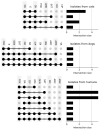Isolation and Identification of Staphylococcus Species Obtained from Healthy Companion Animals and Humans
- PMID: 35202332
- PMCID: PMC8879518
- DOI: 10.3390/vetsci9020079
Isolation and Identification of Staphylococcus Species Obtained from Healthy Companion Animals and Humans
Abstract
The close contact between people and their pets has generated the exchange of skin microbiota, accompanied by bacteria that present resistance to antibiotics. Staphylococcus spp., opportunistic pathogens present in the skin and mucosa of mammals, have had their importance recognized in human and veterinary medicine. The objectives of this study were to identify Staphylococcus spp. present in isolates from the nostrils of healthy humans, dogs and cats as well as to determine their phenotype of resistance to methicillin. Strain identification was performed by MALDI-TOF mass spectrometry and antimicrobial susceptibility was determined using a disk diffusion assay for 12 antibiotics. Sixty humans (veterinary and technicians), sixty dogs and sixty cats were sampled; of them, 61.6%, 56.6% and 46.6%, respectively, carried Staphylococcus spp. in their nostrils, and only two people carried two different species of Staphylococcus in the only anatomical site sampled. A methicillin-resistant phenotype was present in 48.7% of the humans, 26.5% of the dogs and 57.1% of the cats, and sampled. These results demonstrate the presence of Staphylococcus spp. strains resistant to methicillin in personnel who work in contact with animals, as well as in dogs and cats that entered the same hospital or veterinary clinic, which alerts us to the potential transfer of these strains to or between people, dogs and/or cats.
Keywords: Staphylococcus spp.; antimicrobial susceptibility testing; cats; dogs; human; resistance.
Conflict of interest statement
The authors declare no conflict of interest. The funders had no role in the design of the study; in the collection, analyses, or interpretation of data; in the writing of the manuscript; or in the decision to publish the results.
Figures





Similar articles
-
Carriage of methicillin-resistant staphylococci by healthy companion animals in the US.Lett Appl Microbiol. 2014 Jul;59(1):1-8. doi: 10.1111/lam.12254. Epub 2014 Apr 15. Lett Appl Microbiol. 2014. PMID: 24730724
-
Antimicrobial resistance in coagulase-positive staphylococci isolated from companion animals in Australia: A one year study.PLoS One. 2017 Apr 21;12(4):e0176379. doi: 10.1371/journal.pone.0176379. eCollection 2017. PLoS One. 2017. PMID: 28430811 Free PMC article.
-
Commensal Staphylococci Including Methicillin-Resistant Staphylococcus aureus from Dogs and Cats in Remote New South Wales, Australia.Microb Ecol. 2020 Jan;79(1):164-174. doi: 10.1007/s00248-019-01382-y. Epub 2019 May 2. Microb Ecol. 2020. PMID: 31049616
-
Bacterial zoonoses transmitted by household pets and as reservoirs of antimicrobial resistant bacteria.Microb Pathog. 2021 Jun;155:104891. doi: 10.1016/j.micpath.2021.104891. Epub 2021 Apr 18. Microb Pathog. 2021. PMID: 33878397 Review.
-
Multidrug-resistant opportunistic pathogens challenging veterinary infection control.Vet Microbiol. 2017 Feb;200:71-78. doi: 10.1016/j.vetmic.2016.05.017. Epub 2016 May 27. Vet Microbiol. 2017. PMID: 27291944 Review.
Cited by
-
Isolation and characterization of bacteriophages targeting methicillin-resistant Staphylococcus aureus (MRSA) from burn patients and sewage water: a genomic and proteomic study.Int Microbiol. 2025 Aug;28(6):1331-1347. doi: 10.1007/s10123-024-00618-3. Epub 2024 Dec 6. Int Microbiol. 2025. PMID: 39638914
-
Antimicrobial resistance profiles of Staphylococcus spp. and Escherichia coli isolated from dogs and cats in Seoul, South Korea during 2021-2023.Front Vet Sci. 2025 Aug 7;12:1563780. doi: 10.3389/fvets.2025.1563780. eCollection 2025. Front Vet Sci. 2025. PMID: 40852434 Free PMC article.
-
Matrix-assisted laser desorption ionization-time-of-flight mass spectrometry in veterinary medicine: Recent advances (2019-present).Vet World. 2022 Nov;15(11):2623-2657. doi: 10.14202/vetworld.2022.2623-2657. Epub 2022 Nov 21. Vet World. 2022. PMID: 36590115 Free PMC article. Review.
-
Canine Staphylococcaceae circulating in a Kenyan animal shelter.Microbiol Spectr. 2024 Feb 6;12(2):e0292423. doi: 10.1128/spectrum.02924-23. Epub 2024 Jan 11. Microbiol Spectr. 2024. PMID: 38206027 Free PMC article.
-
Fermented Soybean Meal (FSBM) in African Catfish (Clarias gariepinus) Diets: Effects on Growth Performance, Fish Gut Microbiota Analysis, Blood Haematology, and Liver Morphology.Life (Basel). 2022 Nov 11;12(11):1851. doi: 10.3390/life12111851. Life (Basel). 2022. PMID: 36430986 Free PMC article.
References
-
- Tortora G., Berdell F., Case C., Weber D., Bair W. Microbiology: An Introduction. 13th ed. Pearson; Boston, MA, USA: 2019.
-
- Pasachova J., Ramírez S., Muñoz L. Staphylococcus aureus: Generalidades, mecanismos de patogenicidad y colonización celular. Nova. 2019;17:25–38. doi: 10.22490/24629448.3631. - DOI
LinkOut - more resources
Full Text Sources
Miscellaneous

